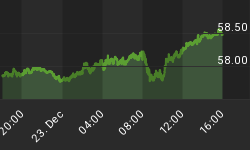Below is an extract from a commentary posted at Everybody knows that the US$ has been under pressure over the past two years as a result of the US's huge current account deficit. It is often the case, though, that what everybody knows is either not worth knowing or is just plain wrong. In this case, it's mostly wrong. The huge current account deficit being run by the US is certainly important to the LONG-TERM bearish case against the US$. Furthermore, a good argument can be made that the US$ will continue to decline until the quarterly current account deficit is reduced to zero (this is an argument we've made in the past and that we continue to think is valid). However, the following chart comparison of the trade-weighted exchange index of the US$ and the quarterly US current account balance indicates that the current account deficit has NOT been the primary driver of the Dollar's bear market to date. Note, in particular, that the deficit grew from $25B to $100B between 1995 and 2001 while the dollar trended HIGHER and has only increased by a relatively small amount since the dollar began to trend lower. It could obviously be argued that an increase in the current account deficit over many years created a build-up of pressure that eventually tipped the US$ over during the first quarter of 2002, but such an argument would miss a very important point. The point is: something changed during 2001-2002 that suddenly made the current account deficit MATTER and it is this "something" that has been the primary driver of the dollar's bear market, not the current account deficit itself. The two shaded areas on the above chart identify the two most recent cyclical bear markets for the US$, the latest of which is on-going. In our opinion, the current bear market will continue until the quarterly current account deficit has been eliminated just as the bear market that began in 1985 continued until the current account deficit was finally reduced to zero in early 1991. However, the chart shows that there is no correlation between the performances of the dollar and the current account balance during any given year and that the dollar can move sharply higher in the face of a deteriorating current account situation. It is therefore nowhere near enough to simply recognise what is happening with the current account balance (the current account balance is just a number that is reported four times per year and is information that every market participant knows). Instead, in order to have a good chance of being right about where the dollar is headed over the coming 1-2 years it is necessary to understand a) what changes occurred in 2001-2002 to make the US current account deficit matter, and b) whether or not these changes are likely to remain in effect. The level of investment demand for dollar-denominated assets and debt determines how the dollar responds to a current account deficit and the reason that the increase in this deficit didn't seem to matter prior to 2002 was that the foreign investment demand for dollars was increasing at a faster rate. In other words, the thing that changed in the early part of 2002 was that the investment demand for dollars began to wane.
The investment demand for dollars is determined by things like nominal interest rates and expected stock-market returns in the US relative to the interest rates and stock-market returns available in other parts of the world. An important determinant of investment demand is also the expected future level of inflation, because investors are primarily concerned with real (inflation-adjusted) returns. This is, of course, why representatives of the Fed spend so much time and effort talking-down the prospects of a US inflation problem and why the US Government goes to the trouble of reporting producer price indices that are so obviously wrong. It's all about creating the illusion that nominal returns are real.
Further to the above, we expect the US$ to fall further before the first major bottom of its long-term bear market is put in place; not because of the large US current account deficit but because we don't see much chance of dollar-denominated assets and debt offering foreign investors enough relative value. Specifically, the US stock market does not look attractive relative to many other markets around the world, nominal interest rates in the US are too low, and the US inflation problem is unlikely to remain under wraps for much longer. The current account deficit is part of the equation, but only to the extent that if the US was not running a large current account deficit it wouldn't need to attract so much new investment each month and the real returns offered by dollar-denominated investments wouldn't be as critical.















